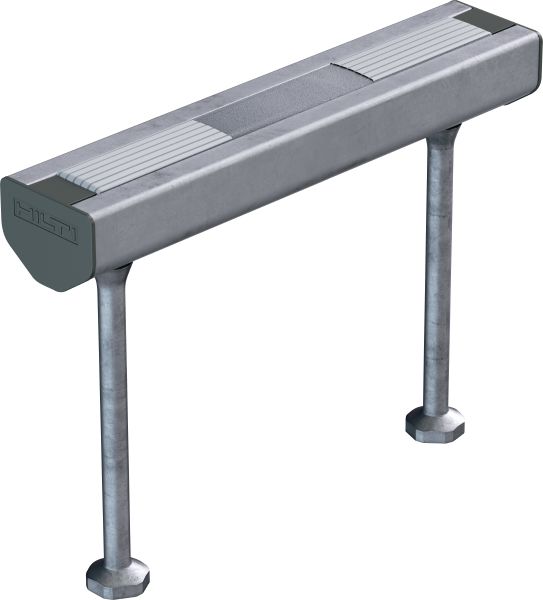Cast-in anchor channels
Anchor channels are a practical, adjustable fastening solution for concrete which can conform with the most rigorous standards and approvals
7 Products

- Description
- Serrated cast-in anchor channels with upgraded load capacity and multiple embedment depths for economical fastening of curtain wall façades
- Material, corrosion
- Carbon Steel, Hot-Dip Galvanized
- Channel profile
- HAC-T50, HAC-T70
- PROFIS Software
- Yes

- Description
- Cast-in anchor channels with upgraded load capacity and multiple embedment depths for economical fastening of curtain wall façades
- Material, corrosion
- Carbon Steel, Hot-Dip Galvanized
- Channel profile
- HAC-V 35, HAC-V 40, HAC-V 50, HAC-V 60, HAC-V 70
- PROFIS Software
- Yes

- Description
- Cast-in anchor channels for front-of-slab applications
- Material, corrosion
- Carbon Steel, Hot-Dip Galvanized
- Channel profile
- HAC-V 50 XT, HAC-V-T 50 XT, HAC-V-T 70 XT, HAC-V 70 XT, HAC-V 50 XTS, HAC-V-T 50 XTS, HAC-V 70 XTS, HAC-V-T 70 XTS
- PROFIS Software
- Yes

- Description
- Cast-in anchor channels in standard sizes and lengths for top-of-slab applications
- Material, corrosion
- Carbon Steel, Hot-Dip Galvanized
- Channel profile
- HAC-V 40 EDGE Lite, HAC-V 35 EDGE Lite, HAC-V 50 EDGE
- PROFIS Software
- Yes

- Description
- Serrated cast-in anchor channels in custom sizes and lengths for top-of-slab installations catering to 3D loads
- Material, corrosion
- Carbon Steel, Hot-Dip Galvanized
- Channel profile
- HAC-V-T 50 EDGE C
- PROFIS Software
- Yes

- Description
- Serrated cast-in anchor channels in custom sizes and lengths for top-of-slab installations catering to 3D loads
- Material, corrosion
- Carbon Steel, Hot-Dip Galvanized
- Channel profile
- HAC-V-T 50 EDGE, HAC-V-T 50 Lite
- PROFIS Software
- Yes

- Description
- Cast-in anchor channels in standard sizes and lengths for top-of-slab corner applications
- Material, corrosion
- Carbon Steel, Hot-Dip Galvanized
- Channel profile
- HAC-V 50 EDGE C
- PROFIS Software
- Yes

Hilti Anchor Channel
A systematic approach to innovative concrete anchoring
Help ensure a quality installation with a reliable load transfer to the concrete structure and a multipoint anchoring system in a single assembly.
Simplicity and Efficiency rolled into one
Hilti anchor channels (HAC) are produced using Temperature Controlled Roll Shaping (TCRS), an innovative process that helps ensure maximum quality and load bearing capacity under static and dynamic loads, while keeping energy consumption and emissions to a minimum.
In conjunction with PROFIS Anchor Channel, Hilti's simplified and value-engineered cast-in anchor channel system portfolio helps designers easily provide model code compliant and cost-effective concrete anchor channel system solutions.
Why cast-in anchor channels are the better solution?
Compared to traditional cast-in technologies, anchor channel systems provide added savings by not requiring skilled labor to connect the fixture since welding is not required. Additionally, anchor channels reduce the installation time per connection, improve the safety of the installer, and increase the structural reliability of the connection.
How does Hilti help you succeed?
Hilti is your partner throughout the life span of your project. We want you to be successful. In a fast paced environment like the construction industry, it is essential to have a reliable partner that supports you with the right product and service solutions, as well as the leading expertise to enable you to complete your project in time and budget.

PROFIS Engineering Façade
Simplify your façade connection design with the Façade module in PROFIS Engineering. This module enables design of cast-in anchor channels, post installed anchors and cast-in embed plates with load transfer from common façade brackets. Elevate your design with productivity features such as importing your loads from Excel, running multiple load combinations in one file, and enabling tolerance adjustments in multiple directions with slotted holes saving significant time from repetitive connection designs.
